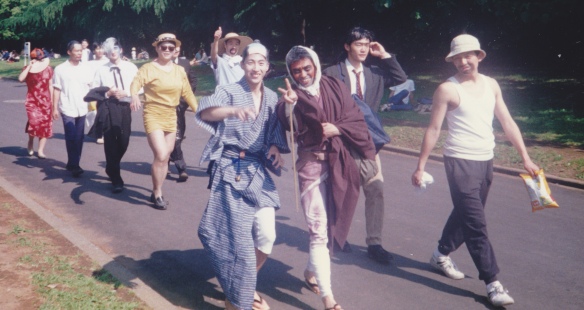Previously on The Free Range: I have had two opportunities to witness street mobs in action, from formation to mayhem to dispersion. The experiences didn’t provide me much in the way of insight. But did they did make an enormous impression on me, and confirm for me what is commonly understood of mob psychology.
Yoyogi-A-Go-Go
Almost exactly ten years after the Seattle Market melee, I found myself in another mob. In May, 1991 I was in Tokyo’s Yoyogi Park with my sister Julie. In this case, no riot ensued, and no one got hurt, but the frightening character of the mob was on display.
Yoyogi Park on any Sunday: just wonderful and bizarre and brilliant. If you ever have the good fortune of visiting Tokyo, stay through Sunday so you can go to Harajuku and walk through Yoyogi Park. There you will see a delightful cultural menagerie, uniquely Japanese, swirling with cross currents of Asian, American and European influence and participation. And it must be one of the best places for people-watching in the world.
 After we had walked through most of the Park and were heading back out, we came to group of a few hundred Iran-jin. They were guest-workers, all young men who were standing together, talking and dancing. The mood was festive, there was music playing, and their street-party spirit was infectious.
After we had walked through most of the Park and were heading back out, we came to group of a few hundred Iran-jin. They were guest-workers, all young men who were standing together, talking and dancing. The mood was festive, there was music playing, and their street-party spirit was infectious.
Three Amerika-jin, a couple of guys and one young woman, were there as well. They had been drinking. They had not been trained in cross-cultural competency. The woman started dancing, as if she were merely joining in the fun. But she was not. She quickly seized the attention of a great many of these bachelor strangers in a strange land. What she thought about her dancing, and what the men thought about it, were two wildly different things. I can’t say what was in their minds, but as I said in my previous post, in a mob there is nothing in the mind at all.
The woman soon found herself the center of attention and, cheered on by the excited crowd, kept her up beer-fueled dance party. Now she was encircled, and the shouting and cheering was all around her. “Woo-hoo! Look at me!”
Yes, we are all looking at you. Is that all you’re going to do? Isn’t there something more? The crowd closed together and in on her and her friends. I believed they were hoping that she would shed some clothing. American women do that, don’t they? But what they wanted was hard to discern.
The Amerika-jin decided that the crowd was crowding them and the men began trying to get them to back off a little. They did not. The woman stopped dancing and her smile turned to fear. Now all of them were trying to push the crowd back and get away. The enthusiasm of the crowd was high, though, and they wanted the show to resume. No, really! We want you to dance some more! I think it was pretty important to them.
To start dancing like that, and after you have stoked the interest of the men, then to just stop – well, it wasn’t playing well. Her friends started shoving the crowd back and shouting furiously at them to let them go their way. Afraid and angry, they had to back their way out of the mob.
Fortunately, it it did not escalate beyond mobbing and trying to touch the woman. They were able to get away. Though it took a while before the mob realized Salome and her friends were gone, when they did, the crowd spread out out as they had been when we arrived.
It was only a close call, more or less a mis-communication between cultures. With a mob, you can’t explain, “I was just dancing because everyone else was. We do that in America, men and women together. I’m not a stripper.” It’s that much harder if they don’t speak your language.
The scene impressed on me just how fast things can change in a crowd, and how they can spin out of control when people don’t understand each other.
These two experiences have convinced me that there is only one wise course if I am in a crowd that turns into a mob: Hanarere.

